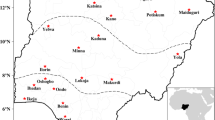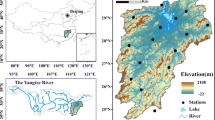Abstract
The analysis of air temperature data from May to September for the period 1966–2022 has revealed the occurrence of extreme phenomena, such as tropical nights and hot days, in the Lake Baikal area. The occurrence, multiyear and intra–annual variability of these extreme phenomena was investigated for the first time. The analysis identified two groups of stations, which are differ in the number and distribution of tropical nights and hot days. The first group, which includes inland and coastal stations, has higher values of the frequency of occurrence of tropical nights (0.21–1.68 days yr –1) and hot days (0.74–8.05 days yr –1). The second group, consisting of coastal, highland and island stations, has predominantly tropical nights (0.19–0.26 days yr –1). After 1990, these extreme events became more frequent. Tropical nights occur between June and September, while hot days are common from May to August, with the highest frequency of both in July. In this month, the proportion of tropical nights and hot days is identical and is 57% of their total number. July is the hottest month in the region. The increase in the frequency of tropical nights and hot days in the Baikal region is mainly due to global warming and changes in global circulation. The occurrence and variability of these extreme phenomena also depend on various factors related to the peculiarities of regional climate warming and local circulation of air masses, as well as on environmental conditions surrounding each station.




Similar content being viewed by others
Data availability
No datasets were generated or analysed during the current study.
References
Aghakouchak AF, Chiang LS, Huning CAL, Mallakpour I, Mazdiyasni O et al (2020) Climate extremes and compound hazards in a warming world. Ann Rev Earth Planet Sci 48:519–548
Bowman DMJS, Williamson GJ, Abatzoglou JT, Kolden CA, Cochrane MA et al (2017) Human exposure and sensitivity to globally extreme wildfire events. Nat Ecol Evol 1:0058
Cantos JO, Serrano-Notivoli R, Miró J, Meseguer-Ruiz O (2019) Tropical nights on the Spanish Mediterranean Coast, 1950–2014. Climate Res 78(3):225–236. https://www.jstor.org/stable/26926450
Cappuccio FP, Cooper D, D’Elia L, Strazzullo P, Miller MA (2011) Sleep duration predicts cardiovascular outcomes: a systematic review and meta-analysis of prospective studies. Eur Heart J 32(12):1484–1492. https://doi.org/10.1093/eurheartj/ehr007PMID
Elizbarashvili M, Elizbarashvili E, Kutaladze N, Elizbarashvili Sh, Maisuradze R et al (2017) Climatology and historical trends in Tropical nights over the Georgian territory. Earth Sciences, Special Issue: New Challenge for Geography. Landsc Dimensions Sustainable Dev 6(5–1):23–30. https://doi.org/10.11648/j.earth.s.2017060501.14
Elsen PR, Monahan WB, Dougherty ER, Merenlender AM (2020) Keeping pace with climate change in global terrestrial protected areas. Sci Adv 6(25):0814. https://doi.org/10.1126/sciadv.aay0814
Fischer EM, Sippel S, Knutti R (2021) Increasing probability of record-shattering climate extremes. Nat Clim Change 11:689–695
Fluctuations of the atmospheric circulation of the Northern Hemisphere in the 20th – beginning of the XXI century. https://atmospheric-circulation.ru/. Accessed 26 June 2023
Galaziy GI (1987) Baikal in questions and answers. East Siberian book publishing house, Irkutsk. (in Russian)
Gasparrini A, Guo Y, Hashizume M, Lavigne E, Zanobetti A et al (2015) Mortality risk attributable to high and low ambient temperature: a multicountry observational study. Lancet 386(9991):369–375. https://doi.org/10.1016/S0140-6736(14)62114-0. PMID: 26003380
Gasparrini A, Guo Y, Sera F, Vicedo-Cabrera AM, Huber V et al (2017) Projections of temperature-related excess mortality under climate change scenarios. Lancet Planet Heal 1(9):e360–e367
Guo Y, Gasparrini A, Armstrong BG, Tawatsupa B, Tobias A, Lavigne E et al (2017) Heat wave and mortality: a multicountry, multicommunity study. Environ Health Perspect 125(8):087006. https://doi.org/10.1289/EHP1026. PMID: 28886602
Hampton SE, Izmest’eva LR, Moore MV, Katz SL, Dennis B, Silow EA (2008) Sixty years of environmental change in the world’s largest freshwater lake – Lake Baikal. Siberia Glob Change Biol 14:1947–1958. https://doi.org/10.1111/j.1365-2486.2008.01616.x
Jaagus J, Rimkus E, Briede A et al (2024) Long-term changes in heat wave parameters in the eastern baltic region. Theor Appl Climatol. https://doi.org/10.1007/s00704-024-04925-7
Kornus O, Danylchenko O, Skyba O (2023) Tropical nights (1976–2019) as an indicator of climate change in Ukraine. IOP Conf Series: Earth Environ Sci 1126:012023. https://doi.org/10.1088/1755-1315/1126/1/012023
Minor K, Bjerre-Nielsen A, Jonasdottir SS, Lehmann S, Obradovich N (2022) Rising temperatures erode human sleep globally. One Earth 5(5):534–549
Murage P, Hajat S, Kovats RS (2017) Effect of night-time temperatures on cause and age-specific mortality in London. Environ Epidemiol 1(2):e005
Olcina CJ, Serrano-Notivoli R, Miró J, Meseguer-Ruiz O (2019) Tropical nights on the Spanish Mediterranean coast, 1950–2014. Clim Res 78:225–236
Park JK, Lu RY, Li CF, Kim EB (2012) Interannual variation of tropical night frequency in Beijing and associated large-scale circulation background. Adv Atmos Sci 29(2):295–306. https://doi.org/10.1007/s00376-011-1141-1
Park TW, Lee CG, Chang M, Park DSR (2022) Regional characteristics of hot days and tropical nights in the Honam area, South Korea. Atmospheric Sci Lett 23(6):e1086. https://doi.org/10.1002/asl.1086
Potemkina TG, Potemkin VL, Fedotov AP (2018) Climatic factors as risks of recent ecological changes in the shallow zone of Lake Baikal. Russ Geol Geophys 59:556–565
Report (2015) On the state of the environment in the Lake Baikal basin: Analytical review of publications on environmental and nature conservation topic. Pulse Radio LLC. (in Russian)
Rippstein V, Schrijver E, Eckert S, Vicedo-Cabrera AM (2023) Trends in tropical nights and their effects on mortality in Switzerland across 50 years. PLOS Clim 2(4):e0000162. https://doi.org/10.1371/journal.pclm.0000162
Roshydromet (2021) Climate change 2021. Overview of the status and trends of climate change in Russia. Roshydromet, Moscow. (in Russian)
Roye D (2017) The effects of hot nights on mortality in Barcelona. Spain. Int J Biometeorol 61(12):2127–2140. https://doi.org/10.1007/s00484-017-1416-zPMID: 28852883
Roye D, Sera F, Tobías A, Lowe R, Gasparrini A et al (2021) Effects of Hot Nights on Mortality in Southern Europe. Epidemiology 32(4):487–98. https://doi.org/10.1097/EDE.0000000000001359 PMID: 33935136
Suleymanov TI, Safarov SG, Ramazanov RG (2016) Assessment of spatial and temporal variability of extreme values of air temperature in the warm period of the year on the north-eastern slope of the Lesser Caucasus (within the Republic of Azerbaijan). Vestnik RUDN, series Ecology and Life Safety 3:66–74
Törnqvist R, Jarsjö J, Pietron J, Bring A, Rogberg P, Asokan S, Destouni G (2014) Evolution of the hydro-climate system in the Lake Baikal basin. J Hydrol 519:1953–1962
Vicedo-Cabrera AM, Scovronick N, Sera F, Roye D, Schneider R et al (2021) The burden of heat related mortality attributable to recent human-induced climate change. Nat Clim Chang 11(6):492–500. https://doi.org/10.1038/s41558-021-01058-xPMID: 34221128
Zhou S, Yu B, Zhang Y (2023) Global concurrent climate extremes exacerbated by anthropogenic climate change. Sci Adv 9:eabo1638. https://doi.org/10.1126/sciadv.abo1638
Zscheischler J, Westra S, Van den Hurk BJJM, Seneviratne SI, Ward PJ et al (2018) Future climate risk from compound events. Nat Clim Change 8:469–477
Zubler EM, Scherrer SC, Croci-Maspoli M, Liniger MA, Appenzeller C (2014) Key climate indices in Switzerland; expected changes in a future climate. Clim Change 123:255–271
Acknowledgements
The work was supported by Ministry of Education and Science of Russia, State Project of Limnological Institute Siberian Branch of Russian Academy of Sciences (grant number 0279–2021–0005).
Funding
Not applicable.
Author information
Authors and Affiliations
Contributions
T.G. and V.L. contributed to the study conception and design. Material preparation, data collection and analysis were performed by authors. T.G. and V.L. reviewed and approved the final manuscript.
Corresponding author
Ethics declarations
Competing interests
The authors declare no competing interests.
Additional information
Publisher’s Note
Springer Nature remains neutral with regard to jurisdictional claims in published maps and institutional affiliations.
Rights and permissions
Springer Nature or its licensor (e.g. a society or other partner) holds exclusive rights to this article under a publishing agreement with the author(s) or other rightsholder(s); author self-archiving of the accepted manuscript version of this article is solely governed by the terms of such publishing agreement and applicable law.
About this article
Cite this article
Potemkina, T., Potemkin, V. Extreme phenomena in the Lake Baikal basin: tropical nights and hot days as indicators of climate warming (Eastern Siberia, Russia). Theor Appl Climatol (2024). https://doi.org/10.1007/s00704-024-05031-4
Received:
Accepted:
Published:
DOI: https://doi.org/10.1007/s00704-024-05031-4




